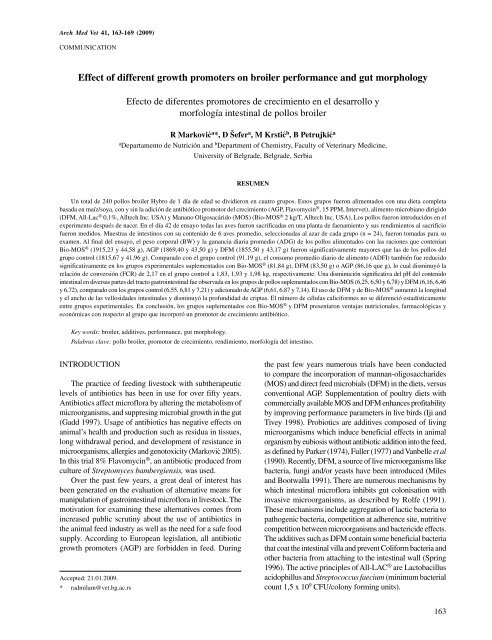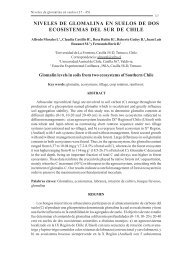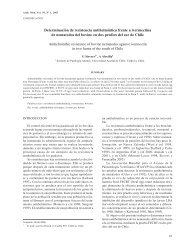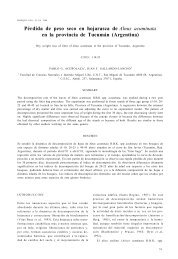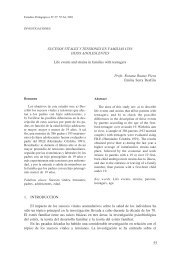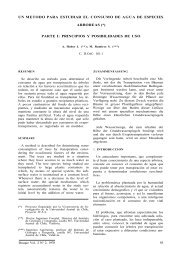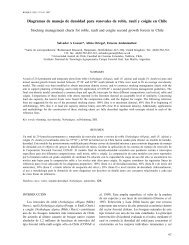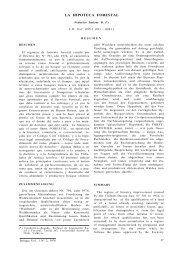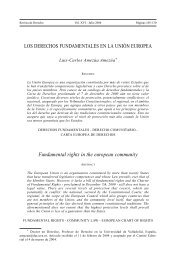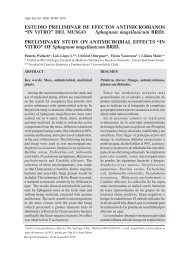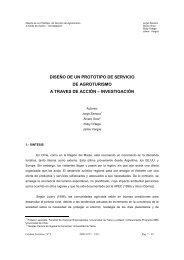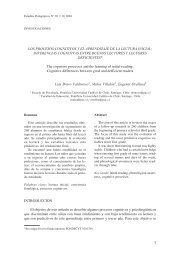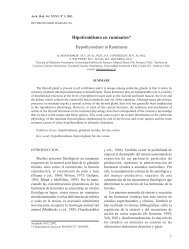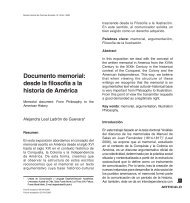Effect of different growth promoters on broiler performance and gut ...
Effect of different growth promoters on broiler performance and gut ...
Effect of different growth promoters on broiler performance and gut ...
Create successful ePaper yourself
Turn your PDF publications into a flip-book with our unique Google optimized e-Paper software.
Arch Med Vet 41, 163-169 (2009)<br />
COMMUNICATION<br />
<str<strong>on</strong>g>Effect</str<strong>on</strong>g> <str<strong>on</strong>g>of</str<strong>on</strong>g> <str<strong>on</strong>g>different</str<strong>on</strong>g> <str<strong>on</strong>g>growth</str<strong>on</strong>g> <str<strong>on</strong>g>promoters</str<strong>on</strong>g> <strong>on</strong> <strong>broiler</strong> <strong>performance</strong> <strong>and</strong> <strong>gut</strong> morphology<br />
Efecto de diferentes promotores de crecimiento en el desarrollo y<br />
morfología intestinal de pollos <strong>broiler</strong><br />
R Markovic a<br />
av *, D Šefera , M Krsticbv , B Petrujkicv<br />
aDepartamento de Nutrición <strong>and</strong> bDepartment <str<strong>on</strong>g>of</str<strong>on</strong>g> Chemistry, Faculty <str<strong>on</strong>g>of</str<strong>on</strong>g> Veterinary Medicine,<br />
University <str<strong>on</strong>g>of</str<strong>on</strong>g> Belgrade, Belgrade, Serbia<br />
RESUMEN<br />
Un total de 240 pollos <strong>broiler</strong> Hybro de 1 día de edad se dividier<strong>on</strong> en cuatro grupos. Estos grupos fuer<strong>on</strong> alimentados c<strong>on</strong> una dieta completa<br />
basada en maíz/soya, c<strong>on</strong> y sin la adición de antibiótico promotor del crecimiento (AGP, Flavomycin ® , 15 PPM, Intervet), alimento microbiano dirigido<br />
(DFM, All-Lac ® 0,1%, Alltech Inc. USA) y Manano Oligosacárido (MOS) (Bio-MOS ® 2 kg/T, Alltech Inc. USA). Los pollos fuer<strong>on</strong> introducidos en el<br />
experimento después de nacer. En el día 42 de ensayo todas las aves fuer<strong>on</strong> sacrificadas en una planta de faenamiento y sus rendimientos al sacrificio<br />
fuer<strong>on</strong> medidos. Muestras de intestinos c<strong>on</strong> su c<strong>on</strong>tenido de 6 aves promedio, selecci<strong>on</strong>adas al azar de cada grupo (n = 24), fuer<strong>on</strong> tomadas para su<br />
examen. Al final del ensayo, el peso corporal (BW) y la ganancia diaria promedio (ADG) de los pollos alimentados c<strong>on</strong> las raci<strong>on</strong>es que c<strong>on</strong>tenían<br />
Bio-MOS ® (1915,23 y 44,58 g), AGP (1869,40 y 43,50 g) y DFM (1855,50 y 43,17 g) fuer<strong>on</strong> significativamente mayores que las de los pollos del<br />
grupo c<strong>on</strong>trol (1815,67 y 41,96 g). Comparado c<strong>on</strong> el grupo c<strong>on</strong>trol (91,19 g), el c<strong>on</strong>sumo promedio diario de alimento (ADFI) también fue reducido<br />
significativamente en los grupos experimentales suplementados c<strong>on</strong> Bio-MOS ® (81,84 g), DFM (83,50 g) o AGP (86,16 que g), lo cual disminuyó la<br />
relación de c<strong>on</strong>versión (FCR) de 2,17 en el grupo c<strong>on</strong>trol a 1,83, 1,93 y 1,98 kg, respectivamente. Una disminución significativa del pH del c<strong>on</strong>tenido<br />
intestinal en diversas partes del tracto gastrointestinal fue observada en los grupos de pollos suplementados c<strong>on</strong> Bio-MOS (6,25, 6,50 y 6,78) y DFM (6,16, 6,46<br />
y 6,72), comparado c<strong>on</strong> los grupos c<strong>on</strong>trol (6,55, 6,81 y 7,21) y adici<strong>on</strong>ado de AGP (6,61, 6,87 y 7,14). El uso de DFM y de Bio-MOS ® aumentó la l<strong>on</strong>gitud<br />
y el ancho de las vellosidades intestinales y disminuyó la pr<str<strong>on</strong>g>of</str<strong>on</strong>g>undidad de criptas. El número de células caliciformes no se diferenció estadísticamente<br />
entre grupos experimentales. En c<strong>on</strong>clusión, los grupos suplementados c<strong>on</strong> Bio-MOS ® y DFM presentar<strong>on</strong> ventajas nutrici<strong>on</strong>ales, farmacológicas y<br />
ec<strong>on</strong>ómicas c<strong>on</strong> respecto al grupo que incorporó un promotor de crecimiento antibiótico.<br />
Key words: <strong>broiler</strong>, additives, <strong>performance</strong>, <strong>gut</strong> morphology.<br />
Palabras clave: pollo <strong>broiler</strong>, promotor de crecimiento, rendimiento, morfología del intestino.<br />
INTRODUCTION the past few years numerous trials have been c<strong>on</strong>ducted<br />
to compare the incorporati<strong>on</strong> <str<strong>on</strong>g>of</str<strong>on</strong>g> mannan-oligosaccharides<br />
The practice <str<strong>on</strong>g>of</str<strong>on</strong>g> feeding livestock with subtherapeutic (MOS) <strong>and</strong> direct feed microbials (DFM) in the diets, versus<br />
levels <str<strong>on</strong>g>of</str<strong>on</strong>g> antibiotics has been in use for over fifty years. c<strong>on</strong>venti<strong>on</strong>al AGP. Supplementati<strong>on</strong> <str<strong>on</strong>g>of</str<strong>on</strong>g> poultry diets with<br />
Antibiotics affect micr<str<strong>on</strong>g>of</str<strong>on</strong>g>lora by altering the metabolism <str<strong>on</strong>g>of</str<strong>on</strong>g> commercially available MOS <strong>and</strong> DFM enhances pr<str<strong>on</strong>g>of</str<strong>on</strong>g>itability<br />
microorganisms, <strong>and</strong> suppresing microbial <str<strong>on</strong>g>growth</str<strong>on</strong>g> in the <strong>gut</strong> by improving <strong>performance</strong> parameters in live birds (Iji <strong>and</strong><br />
(Gadd 1997). Usage <str<strong>on</strong>g>of</str<strong>on</strong>g> antibiotics has negative effects <strong>on</strong> Tivey 1998). Probiotics are additives composed <str<strong>on</strong>g>of</str<strong>on</strong>g> living<br />
animal’s health <strong>and</strong> producti<strong>on</strong> such as residua in tissues, microorganisms which induce beneficial effects in animal<br />
l<strong>on</strong>g withdrawal period, <strong>and</strong> development <str<strong>on</strong>g>of</str<strong>on</strong>g> resistance in organism by eubiosis without antibiotic additi<strong>on</strong> into the feed,<br />
microorganisms, allergies <strong>and</strong> genotoxicity (Markovicv 2005). as defined by Parker (1974), Fuller (1977) <strong>and</strong> Vanbelle et al<br />
In this trial 8% Flavomycin ® , an antibiotic produced from (1990). Recently, DFM, a source <str<strong>on</strong>g>of</str<strong>on</strong>g> live microorganisms like<br />
culture <str<strong>on</strong>g>of</str<strong>on</strong>g> Streptomyces bambergiensis, was used. bacteria, fungi <strong>and</strong>/or yeasts have been introduced (Miles<br />
Over the past few years, a great deal <str<strong>on</strong>g>of</str<strong>on</strong>g> interest has <strong>and</strong> Bootwalla 1991). There are numerous mechanisms by<br />
been generated <strong>on</strong> the evaluati<strong>on</strong> <str<strong>on</strong>g>of</str<strong>on</strong>g> alternative means for which intestinal micr<str<strong>on</strong>g>of</str<strong>on</strong>g>lora inhibits <strong>gut</strong> col<strong>on</strong>isati<strong>on</strong> with<br />
manipulati<strong>on</strong> <str<strong>on</strong>g>of</str<strong>on</strong>g> gastrointestinal micr<str<strong>on</strong>g>of</str<strong>on</strong>g>lora in livestock. The invasive microorganisms, as described by Rolfe (1991).<br />
motivati<strong>on</strong> for examining these alternatives comes from These mechanisms include aggregati<strong>on</strong> <str<strong>on</strong>g>of</str<strong>on</strong>g> lactic bacteria to<br />
increased public scrutiny about the use <str<strong>on</strong>g>of</str<strong>on</strong>g> antibiotics in pathogenic bacteria, competiti<strong>on</strong> at adherence site, nutritive<br />
the animal feed industry as well as the need for a safe food competiti<strong>on</strong> between microorganisms <strong>and</strong> bactericide effects.<br />
supply. According to European legislati<strong>on</strong>, all antibiotic The additives such as DFM c<strong>on</strong>tain some beneficial bacteria<br />
<str<strong>on</strong>g>growth</str<strong>on</strong>g> <str<strong>on</strong>g>promoters</str<strong>on</strong>g> (AGP) are forbidden in feed. During that coat the intestinal villa <strong>and</strong> prevent Coliform bacteria <strong>and</strong><br />
other bacteria from attaching to the intestinal wall (Spring<br />
1996). The active principles <str<strong>on</strong>g>of</str<strong>on</strong>g> All-LAC ® are Lactobacillus<br />
Accepted: 21.01.2009. acidophillus <strong>and</strong> Streptococcus faecium (minimum bacterial<br />
* radmilam@vet.bg.ac.rs count 1,5 x 10 9 CFU/col<strong>on</strong>y forming units).<br />
163
R MARKOVIC ET AL<br />
Prebiotics have been defined as n<strong>on</strong> digestible feed<br />
ingredients, which are <str<strong>on</strong>g>growth</str<strong>on</strong>g> substrates, specifically<br />
directed towards potentially beneficial bacteria already<br />
existing in caecum <strong>and</strong> col<strong>on</strong>. Several studies have shown<br />
that additi<strong>on</strong> <str<strong>on</strong>g>of</str<strong>on</strong>g> prebiotics to the diet <str<strong>on</strong>g>of</str<strong>on</strong>g> <strong>broiler</strong>, layer <strong>and</strong><br />
pig leads to improved <strong>performance</strong> through improving <strong>gut</strong><br />
micr<str<strong>on</strong>g>of</str<strong>on</strong>g>lora (Xu et al 2003, Spring et al 2000, Pelicano et al<br />
2004). In c<strong>on</strong>trast to the antibiotic mode <str<strong>on</strong>g>of</str<strong>on</strong>g> acti<strong>on</strong>, which<br />
limits or suppresses <str<strong>on</strong>g>growth</str<strong>on</strong>g> <str<strong>on</strong>g>of</str<strong>on</strong>g> comm<strong>on</strong> Gram-positive<br />
micr<str<strong>on</strong>g>of</str<strong>on</strong>g>lora, mannan-oligosaccharides (Bio-MOS ® ) <strong>and</strong><br />
other oligosaccharides can prevent attachment <str<strong>on</strong>g>of</str<strong>on</strong>g> Gramnegative<br />
pathogens to enterocytes. Bio-MOS ® derived<br />
from Saccharomyces cerevisiae cell wall, is comm<strong>on</strong>ly<br />
available as a feed supplement, <strong>and</strong> is included in diets<br />
as a generally recognised safe compound. The benefits <str<strong>on</strong>g>of</str<strong>on</strong>g><br />
MOS are based <strong>on</strong> <str<strong>on</strong>g>different</str<strong>on</strong>g> specific properties including<br />
reducti<strong>on</strong> <str<strong>on</strong>g>of</str<strong>on</strong>g> the intestinal mucous cells turnover rate (Iji<br />
<strong>and</strong> Tivey 1998). These properties have the potential to<br />
enhance <str<strong>on</strong>g>growth</str<strong>on</strong>g> rate <strong>and</strong> feed c<strong>on</strong>versi<strong>on</strong> in commercial<br />
<strong>broiler</strong>s diet. Bacterial pathogens, which bind to the intestinal<br />
wall via mannose bearing lectins, bind to the dietary<br />
MOS instead <strong>and</strong> are eliminated harmlessly (Shar<strong>on</strong> <strong>and</strong><br />
Lis 1993). The removal <str<strong>on</strong>g>of</str<strong>on</strong>g> AGPs has led to the search <str<strong>on</strong>g>of</str<strong>on</strong>g><br />
alternative <str<strong>on</strong>g>growth</str<strong>on</strong>g> <str<strong>on</strong>g>promoters</str<strong>on</strong>g>. The alternative products must<br />
be safe for animals, c<strong>on</strong>sumers <strong>and</strong> the envir<strong>on</strong>ment.<br />
The objective <str<strong>on</strong>g>of</str<strong>on</strong>g> this trial was to investigate the effect<br />
<str<strong>on</strong>g>of</str<strong>on</strong>g> dietary supplementati<strong>on</strong> with Bio-MOS ® (Alltech Inc,<br />
USA), direct-fed microbials (All-Lac ® , Alltech Inc, USA) <strong>and</strong><br />
antibiotic <str<strong>on</strong>g>growth</str<strong>on</strong>g> <str<strong>on</strong>g>promoters</str<strong>on</strong>g> (AGP, Flavomycin ® , Intervet)<br />
<strong>on</strong> the <strong>performance</strong>s <strong>and</strong> <strong>gut</strong> morphology <str<strong>on</strong>g>of</str<strong>on</strong>g> <strong>broiler</strong>s. The<br />
gastrointestinal tract is a fr<strong>on</strong>t - defense line against the<br />
c<strong>on</strong>stant invasi<strong>on</strong> <str<strong>on</strong>g>of</str<strong>on</strong>g> microbes. The gastrointestinal fauna <str<strong>on</strong>g>of</str<strong>on</strong>g><br />
the bird is an important factor in poultry <strong>performance</strong> <strong>and</strong><br />
flock health.<br />
MATERIAL AND METHODS<br />
The completely r<strong>and</strong>omised experimental design<br />
included 240 <strong>on</strong>e-day-old male <strong>broiler</strong> chicks (sexed,<br />
Hybro) from a commercial hatchery. Animals were fed<br />
commercial complete corn-soybean based diets (table 1).<br />
Diet 1 was used from 1 st to 20 th day, diet 2 from 21 st to 34 th<br />
day <strong>and</strong> finally diet 3 was used from 35 th until 42 nd day.<br />
Four treatment groups <str<strong>on</strong>g>of</str<strong>on</strong>g> 60 chickens each, were fed the<br />
diet with supplementati<strong>on</strong> <str<strong>on</strong>g>of</str<strong>on</strong>g> AGP (15 ppm Flavomycin ® ,<br />
AGP group), DFM (All-LAC ® 1kg/T, DFM group), 2 kg/T<br />
Bio-MOS ® (MOS group) <strong>and</strong> withouth additives (c<strong>on</strong>trol<br />
group). All birds had ad libitum access to feed.<br />
The following parameters were evaluated during the<br />
experimental period: body weight (<strong>on</strong> day 42), average body<br />
weight gain, feed intake <strong>and</strong> feed gain ratio. Feed intake<br />
was measured <strong>on</strong> a daily basis, as the difference between<br />
the feed mass given to the animals <strong>and</strong> the feed mass left in<br />
the rack. At day 42 <str<strong>on</strong>g>of</str<strong>on</strong>g> trial, all <strong>broiler</strong>s were c<strong>on</strong>venti<strong>on</strong>aly<br />
sacrificed by cervical dislocati<strong>on</strong> technique, as described in<br />
the Report <str<strong>on</strong>g>of</str<strong>on</strong>g> theAVMA Panel <strong>on</strong> Euthanasia (AVMA 2001).<br />
164<br />
Table 1. Compositi<strong>on</strong> <str<strong>on</strong>g>of</str<strong>on</strong>g> experimental diets at days 1- 42 <str<strong>on</strong>g>of</str<strong>on</strong>g> age.<br />
Composición de dietas experimentales entre 1- 42 días de edad.<br />
Diet<br />
1 2 3<br />
(1.-20. días) (21.-34. días) (35.-42. día)<br />
Ingredient<br />
Maize 56.73 63.30 67.75<br />
Soybean meal 26.30 15.30 17.00<br />
Fishmeal 4.00 4.00 –<br />
Sunflower meal – 5.00 6.00<br />
Gluten meal, corn 6.00 6.00 4.00<br />
Oil 3.00 3.00 2.00<br />
Limest<strong>on</strong>e 1.10 0.70 1.00<br />
Dicalcium phosphate 1.30 1.30 1.00<br />
Salt 0.20 0.25 0.25<br />
Methi<strong>on</strong>ine 0.12 – –<br />
Lysine 0.25 0.15 –<br />
Vitamin-mineral<br />
premix* 1.00 1.00 1.00<br />
Calculated compositi<strong>on</strong> %<br />
Protein 21.80 19.40 17.30<br />
Ca 1.07 0.89 0.75<br />
P 0.74 0.75 0.61<br />
ME, MJ/kg 12.96 13.27 13.15<br />
Lysine<br />
Methi<strong>on</strong>ine +<br />
1.38 1.05 0.76<br />
cystine 0.78 0.63 0.55<br />
* including Flavomycin ® , DFM or Bio-MOS ® .<br />
Samples <str<strong>on</strong>g>of</str<strong>on</strong>g> small intestine (sec<strong>on</strong>d third), which corresp<strong>on</strong>d<br />
to the surpass <str<strong>on</strong>g>of</str<strong>on</strong>g> duodenum to jejunum, <strong>and</strong> jejunum to<br />
ileum, were taken for examinati<strong>on</strong> from 6 average <strong>broiler</strong>s<br />
(r<strong>and</strong>omly selected) from each group (n = 24) Secti<strong>on</strong>s <str<strong>on</strong>g>of</str<strong>on</strong>g><br />
5-8 mm thickness were taken from each sample <strong>and</strong> fixed<br />
in 10% formalin soluti<strong>on</strong> <strong>and</strong> absolute alcohol <strong>and</strong> embedded<br />
in paraffin. Secti<strong>on</strong>s were cut, mounted <strong>on</strong> slides <strong>and</strong><br />
stained with the HE method as described by Scheuer <strong>and</strong><br />
Chalk (1986). Morphometric examinati<strong>on</strong>s (villus height <strong>and</strong><br />
width, as well as crypt depth) were d<strong>on</strong>e by light microscopy<br />
using an ocular micrometer 1:100 as described by Djolai<br />
et al (1998), while stereologic determinati<strong>on</strong> <str<strong>on</strong>g>of</str<strong>on</strong>g> goblet cells<br />
number was carried out using a multipurpose test system<br />
M42 as described by Wiebel (1979). At the end <str<strong>on</strong>g>of</str<strong>on</strong>g> the trial,<br />
the pH <str<strong>on</strong>g>of</str<strong>on</strong>g> intestinal c<strong>on</strong>tent in <str<strong>on</strong>g>different</str<strong>on</strong>g> gastrointestinal parts<br />
(duodenum, ileum, caecum) was measured.<br />
STATISTICAL ANALYSIS<br />
The values obtained were expressed as mean ± SD.<br />
In order to analise the relati<strong>on</strong> between intergroup mean
differences, ANOVA, Tukey <strong>and</strong> student’s t-tests were<br />
performed at significance levels <str<strong>on</strong>g>of</str<strong>on</strong>g> 1% <strong>and</strong> 5% (Snedecor<br />
<strong>and</strong> Cochran 1971). S<str<strong>on</strong>g>of</str<strong>on</strong>g>tware package PrismaPad v.4.0<br />
was used for statistical calculati<strong>on</strong>.<br />
RESULTS AND DISCUSSION<br />
Body weight, average <str<strong>on</strong>g>growth</str<strong>on</strong>g>, daily feed intake <strong>and</strong><br />
feed gain ratio during the entire trial period are presented<br />
in table 2.<br />
After 42 days, it was observed that the BW <str<strong>on</strong>g>of</str<strong>on</strong>g> the animals<br />
fed with Bio-MOS ® diet differed significantly compared<br />
to the other groups (P < 0.05). This led to significantly<br />
higher body weight gain in the experimental rather than<br />
in the c<strong>on</strong>trol group during the total period (P < 0.05).<br />
Feed c<strong>on</strong>versi<strong>on</strong> was also reduced significantly when Bio-<br />
MOS ® , DFM or AGP were administered to the feed <strong>and</strong><br />
this was observed during the entire trial period (table 2,<br />
P < 0.05). As a result, feed to gain ratio was significantly<br />
reduced in trial groups compared to the c<strong>on</strong>trol <strong>and</strong> the<br />
AGP fed birds (P < 0.05).<br />
BROILER, ADDITIVES, PERFORMANCE, GUT MORPHOLOGY<br />
The data presented in the table 3 shows that electrochemical<br />
reacti<strong>on</strong> increases al<strong>on</strong>g the digestive tract <str<strong>on</strong>g>of</str<strong>on</strong>g><br />
<strong>broiler</strong>s, with the highest values being registered in the<br />
terminal parts <str<strong>on</strong>g>of</str<strong>on</strong>g> the intestines in all groups included in<br />
the trial. The differences <str<strong>on</strong>g>of</str<strong>on</strong>g> pH values between c<strong>on</strong>trol<br />
<strong>and</strong> AGP group am<strong>on</strong>g corresp<strong>on</strong>ding segments <str<strong>on</strong>g>of</str<strong>on</strong>g> the<br />
intestines were n<strong>on</strong>-significant, while the decrease <str<strong>on</strong>g>of</str<strong>on</strong>g><br />
the pH in the duodenal c<strong>on</strong>tent ranged from significant<br />
(P < 0.05) to very significant (P < 0.01) in the other two<br />
groups.<br />
The supplementati<strong>on</strong> with Bio-MOS ® <strong>and</strong> DFM led<br />
to an increase in villus height <strong>and</strong> width, as well as a decrease<br />
in crypt depth in all parts <str<strong>on</strong>g>of</str<strong>on</strong>g> the intestine (P < 0.05),<br />
(table 4, figures 1-3).<br />
Supplementati<strong>on</strong> <str<strong>on</strong>g>of</str<strong>on</strong>g> animal diets with various additives<br />
aims to increase producti<strong>on</strong> <strong>and</strong> quality <str<strong>on</strong>g>of</str<strong>on</strong>g> food<br />
<str<strong>on</strong>g>of</str<strong>on</strong>g> animal origin. The results obtained in the present<br />
study are similar to those described by Roch (1998)<br />
<strong>and</strong> Waldroup et al (1970) obtained in nutriti<strong>on</strong> experiments<br />
with antibiotic <strong>and</strong> Bio-MOS ® . Probiotics<br />
induce similar <strong>and</strong> even better effects compared to<br />
Table 2. Average body weight (BW), average body <strong>broiler</strong> weight gain (BWG), average daily feed intake (ADFI) <strong>and</strong> average feed<br />
c<strong>on</strong>versi<strong>on</strong> ratio (FCR) during the entire trial period for the <strong>broiler</strong> treatment groups.<br />
Promedios de peso corporal (BW), de aumento del peso corporal (BWG), del c<strong>on</strong>sumo diario de alimento (ADFI) y del cociente de c<strong>on</strong>versión<br />
de la alimentación (FCR) durante el período de prueba completo para los grupos de <strong>broiler</strong> en tratamiento.<br />
Parameters<br />
BW (kg)<br />
BWG (g/d)<br />
ADFI (g/d)<br />
FCR (kg)<br />
Values expressed as x–;<br />
* AGP - Antibiotic Growth Promoters<br />
** DFM - Direct Feed Microbials<br />
*** MOS - Manan Oligo Saccharids<br />
C<strong>on</strong>trol<br />
1815.67 a<br />
41.96a, b, c<br />
91.19<br />
2.17<br />
Group<br />
AGP* DFM** MOS***<br />
1869.40 b<br />
43.50 a<br />
86.16<br />
1.98<br />
a, b, c P < 0.05<br />
Table 3. Mean <strong>and</strong> st<strong>and</strong>ard deviati<strong>on</strong> for pH value <str<strong>on</strong>g>of</str<strong>on</strong>g> chime in the intestine <str<strong>on</strong>g>of</str<strong>on</strong>g> <strong>broiler</strong>s <strong>on</strong> day 42.<br />
Media y desviación estándar para el valor de pH del quimo en el intestino de los <strong>broiler</strong>s en el día 42.<br />
Segment<br />
Duodenum<br />
Ileum<br />
Caecum<br />
Values expressed as x–; SD;<br />
* AGP - Antibiotic Growth Promoters<br />
** DFM - Direct Feed Microbials<br />
*** MOS - Manan Oligo Saccharids<br />
C<strong>on</strong>trol AGP*<br />
6.55 ± 0.25a, A 6.61 ± 0.26b, B<br />
6.81 ± 0.20a, b 6.87 ± 0.33c, d<br />
7.21 ± 0.33a, b, A 7.14 ± 0.24c, d<br />
a, b, c, dP < 0.05;<br />
Group<br />
1855.50 c<br />
43.17 b<br />
83.50<br />
1.93<br />
1915.23a, b, c<br />
44.58c 81.84<br />
1.84<br />
DFM** MOS***<br />
6.16 ± 0.15A, B 6.25 ± 0.21a, b,<br />
6.46 ± 0.21c 6.50 ± 0.26b, d<br />
6.72 ± 0.26b, c, A 6.78 ± 0.29a, d<br />
A,BP < 0.01<br />
165
R MARKOVIC ET AL<br />
Table 4. <str<strong>on</strong>g>Effect</str<strong>on</strong>g> <str<strong>on</strong>g>of</str<strong>on</strong>g> treatments <strong>on</strong> <strong>broiler</strong> <strong>gut</strong> morphology [µm] <strong>on</strong> day 42.<br />
Efecto de los tratamientos en la morfología del intestino de los <strong>broiler</strong>s [µm] en el día 42.<br />
Group<br />
C<strong>on</strong>trol AGP* DFM** MOS***<br />
Duodenum<br />
Villus height 901.28 ± 70.02a, b 981.07 ± 77.01c, d 1008.35 ± 40.64a, c 1013.08 ± 81.98b, d<br />
Villus width 93.72 ± 15.11a, b, c 98.58 ± 8.10a 104.48 ± 17.40b 107.70 ± 13.91c Crypt depth 140.35 ± 27.20a, b 137.52 ± 18.23c, d 126.18 ± 30.06a, c 123.72 ± 32.10b, d<br />
Ileum<br />
Villus height 452.77 ± 181.13a, b, A 478.32 ± 124.35c, d, B 541.27 ± 100.82a, c 640.53±115.95 b, d, A, B<br />
Villus width 87.15 ± 10.92a 90.28 ± 18.83b 90.05 ± 13.53c 95.12 ± 12.30a, b, c<br />
Crypt depth 111.93 ± 14.06a, b 103.98 ± 34.03c, d 84.20 ± 24.90a, c 86.52 ± 10.90b, d<br />
Caecum<br />
Villus height 160.22 ± 29.77a, b 163.08 ± 48.67c 166.48 ± 46.19a 171.25 ± 44.06b, c<br />
Villus width 59.08 ± 6.55a, b, c 66.77 ± 12.34a 65.27 ± 10.49b 65.10 ± 16.29c Crypt depth 42.23 ± 11.77a, b 40.83 ± 8.67c, d 31.37 ± 8.53a. c 31.75 ± 7.82b. d<br />
Values expressed as x–; SD; a, b, c, dP < 0.05 A, P < 0.01<br />
* AGP - Antibiotic Growth Promoters.<br />
** DFM - Direct Feed Microbials.<br />
*** MOS - Manan Oligo Saccharids.<br />
a. C<strong>on</strong>trol b. AGP c. DFM d. MOS<br />
Figure 1. Histological figure <str<strong>on</strong>g>of</str<strong>on</strong>g> <strong>broiler</strong> duodenum (obj. 1:100, HE) for <str<strong>on</strong>g>different</str<strong>on</strong>g> treatment groups.<br />
Figura histológica de duodeno de <strong>broiler</strong> (obj. 1:100, HE) para los diversos grupos en tratamiento.<br />
Flavomycin ® as defined by Owings et al (1990). The<br />
increased weight gain is achieved by prebiotics <strong>and</strong> the<br />
increased range from 2-6%, as reported by Kumprecht<br />
et al (1998), Roch (1998), Petersen (1998), Newman<br />
Melissa (1990) <strong>and</strong> Pupavac et al (1998). This was also<br />
c<strong>on</strong>firmed in our trial for prebiotic supplementati<strong>on</strong><br />
(MOS group).<br />
166<br />
Adding MOS in <strong>broiler</strong> feed significantly increased<br />
villous length but not villous width as reported by Spring<br />
(1996). Besides Bradly et al (1994) noticed simultaneous<br />
decrease <str<strong>on</strong>g>of</str<strong>on</strong>g> crypt depth, which is in agreement with reports<br />
by Savage et al (1997).<br />
There is substantial evidence that dietary MOS modifies<br />
the morphology <strong>and</strong> structure <str<strong>on</strong>g>of</str<strong>on</strong>g> the intestinal mucous as
BROILER, ADDITIVES, PERFORMANCE, GUT MORPHOLOGY<br />
a. C<strong>on</strong>trol b. AGP c. DFM d. MOS<br />
Figure 2. Histological figure <str<strong>on</strong>g>of</str<strong>on</strong>g> <strong>broiler</strong> ileum, (obj. 1:100, HE) for <str<strong>on</strong>g>different</str<strong>on</strong>g> treatment groups.<br />
Figura histológica de ile<strong>on</strong> de <strong>broiler</strong>, (obj. 1:100, HE) para los diversos grupos en tratamiento.<br />
a. C<strong>on</strong>trol b. AGP c. DFM d. MOS<br />
Figure 3. Histological figure <str<strong>on</strong>g>of</str<strong>on</strong>g> <strong>broiler</strong> caecum, (obj. 1:100, HE) for <str<strong>on</strong>g>different</str<strong>on</strong>g> treatment groups.<br />
Figura histológica de intestino ciego de <strong>broiler</strong>, (obj. 1:100, HE) para los diversos grupos en tratamiento.<br />
defined by Shane (2001). Enterocytes undergo a c<strong>on</strong>tinual<br />
cycle <str<strong>on</strong>g>of</str<strong>on</strong>g> proliferati<strong>on</strong> in the intestinal crypt, cell maturati<strong>on</strong><br />
<strong>and</strong> migrati<strong>on</strong> up the villa with desquamati<strong>on</strong> at the tip<br />
<str<strong>on</strong>g>of</str<strong>on</strong>g> the villa. The depth <str<strong>on</strong>g>of</str<strong>on</strong>g> the crypts is correlated to cell<br />
replacement rate (Savage et al 1997). Accelerated replacement<br />
<str<strong>on</strong>g>of</str<strong>on</strong>g> enterocytes requires energy <strong>and</strong> proteins, which<br />
can deprive <str<strong>on</strong>g>growth</str<strong>on</strong>g> <strong>and</strong> the development <str<strong>on</strong>g>of</str<strong>on</strong>g> other tissues<br />
<strong>and</strong> organ systems. Thus, the decreased crypt height will<br />
be correlated to a significant increase in <str<strong>on</strong>g>growth</str<strong>on</strong>g> rate as<br />
occurred in the present study.<br />
Adding DFM to <strong>broiler</strong> feed provides more stable resident<br />
micr<str<strong>on</strong>g>of</str<strong>on</strong>g>lora, which c<strong>on</strong>sequently provides better<br />
c<strong>on</strong>diti<strong>on</strong>s for l<strong>on</strong>ger enterocyte life. L<strong>on</strong>ger villa increases<br />
the absorptive surface <str<strong>on</strong>g>of</str<strong>on</strong>g> intestines, while smaller crypts<br />
indicate lower tissue turnover as well as lower dem<strong>and</strong><br />
for tissue development.<br />
The evaluati<strong>on</strong>s performed have c<strong>on</strong>firmed that<br />
antibiotics applied as <str<strong>on</strong>g>growth</str<strong>on</strong>g> <str<strong>on</strong>g>promoters</str<strong>on</strong>g> gave positive<br />
effects <strong>on</strong> average weight gain (5% higher, <strong>on</strong> average)<br />
<strong>and</strong> <strong>on</strong> feed to gain ratio (approximate decrease <str<strong>on</strong>g>of</str<strong>on</strong>g> 6%) in<br />
growing animals as reported by Gadd (1997). It has also<br />
been c<strong>on</strong>firmed that feed supplements with probiotic <strong>and</strong><br />
prebiotic effects both act as efficient <str<strong>on</strong>g>growth</str<strong>on</strong>g> <str<strong>on</strong>g>promoters</str<strong>on</strong>g> in<br />
domestic fowl, i.e. increasing daily gain for 8-10% with<br />
decreased feed gain ratio for 10-15%, as described by<br />
Petersen (1998) <strong>and</strong> Owings et al (1990). On the basis<br />
<str<strong>on</strong>g>of</str<strong>on</strong>g> data obtained it was c<strong>on</strong>cluded that alternative <str<strong>on</strong>g>growth</str<strong>on</strong>g><br />
<str<strong>on</strong>g>promoters</str<strong>on</strong>g> enhance <str<strong>on</strong>g>growth</str<strong>on</strong>g> by stimulati<strong>on</strong> <str<strong>on</strong>g>of</str<strong>on</strong>g> physiological<br />
167
R MARKOVIC ET AL<br />
potentials <strong>and</strong> mechanisms in animals together with avoiding<br />
antibiotics in feeds as described by Ferket et al (2002)<br />
<strong>and</strong> Newman (2002). Probiotic <strong>and</strong> prebiotic supplements<br />
accomplish similar effects <strong>on</strong> animals as antibiotics, while<br />
undesired effects like tissue residua, withdrawal period,<br />
development <str<strong>on</strong>g>of</str<strong>on</strong>g> resistance in microorganisms, allergies,<br />
genotoxic effects, etc. are avoided as reported by Veld<br />
(1997) <strong>and</strong> Hooge (2003).<br />
Antibiotics induce enlargement <str<strong>on</strong>g>of</str<strong>on</strong>g> villous length <strong>and</strong><br />
width al<strong>on</strong>g with a decrease <str<strong>on</strong>g>of</str<strong>on</strong>g> depth <str<strong>on</strong>g>of</str<strong>on</strong>g> intestinal crypts,<br />
which can be correlated with a decrease <str<strong>on</strong>g>of</str<strong>on</strong>g> total microbial<br />
populati<strong>on</strong> <strong>and</strong> a shift to more beneficial compositi<strong>on</strong> <str<strong>on</strong>g>of</str<strong>on</strong>g><br />
intestinal micr<str<strong>on</strong>g>of</str<strong>on</strong>g>lora.<br />
These effects, especially the observed increase in duodenal<br />
villous length <strong>and</strong> decreased depth <str<strong>on</strong>g>of</str<strong>on</strong>g> the crypts are<br />
potentiated when probiotics are used. Dunham et al (1993)<br />
presented similar c<strong>on</strong>clusi<strong>on</strong>s in domestic fowl fed a diet<br />
supplemented with L. Reuteri which had l<strong>on</strong>ger villa <strong>and</strong><br />
lower crypts in ileum compared to the c<strong>on</strong>trols.<br />
The most evident positive effects <strong>on</strong> digesti<strong>on</strong> were<br />
achieved in intestines <str<strong>on</strong>g>of</str<strong>on</strong>g> <strong>broiler</strong>s fed with feed supplemented<br />
with MOS. Olygosacharides can act negatively <strong>on</strong> digesti<strong>on</strong><br />
<str<strong>on</strong>g>of</str<strong>on</strong>g> energetic comp<strong>on</strong>ents as described by Co<strong>on</strong> et al (1990)<br />
<strong>and</strong> Leske et al (1993), as well as <strong>on</strong> the fact that volatile<br />
fatty acids stimulate peristalsis, therefore diminishing the<br />
period <str<strong>on</strong>g>of</str<strong>on</strong>g> food passage <strong>and</strong> possible time <str<strong>on</strong>g>of</str<strong>on</strong>g> absorpti<strong>on</strong><br />
as reported by Hellendro<strong>on</strong> (1979). On the other h<strong>and</strong>, a<br />
compensatory mechanism reflected <strong>on</strong> the increase <str<strong>on</strong>g>of</str<strong>on</strong>g> villa<br />
length in the ileum has been reported by Choi et al (1994).<br />
Spring (1996) c<strong>on</strong>firmed that mannan-olygocacharides in<br />
feed have a significant effect (P < 0.05) <strong>on</strong> the length <str<strong>on</strong>g>of</str<strong>on</strong>g><br />
the intestinal villa. They did not observe any significant<br />
difference in the width <str<strong>on</strong>g>of</str<strong>on</strong>g> the villa. The results obtained<br />
by Bradley et al (1994) <strong>and</strong> Shane (2001), who revealed<br />
that al<strong>on</strong>g with the increase <str<strong>on</strong>g>of</str<strong>on</strong>g> the length <str<strong>on</strong>g>of</str<strong>on</strong>g> intestinal<br />
villa a decrease <str<strong>on</strong>g>of</str<strong>on</strong>g> the crypt depth is observed, agree with<br />
this finding. The results <str<strong>on</strong>g>of</str<strong>on</strong>g> Savage et al (1997) have also<br />
c<strong>on</strong>firmed that the depth <str<strong>on</strong>g>of</str<strong>on</strong>g> the crypts is decreased in the<br />
intestine <str<strong>on</strong>g>of</str<strong>on</strong>g> the <strong>broiler</strong>s treated with MOS.<br />
The described changes in intestinal morphology can<br />
explain the observed beneficial effects <strong>on</strong> productivity, as<br />
reported by Loodi et al (2004). The enlargement <str<strong>on</strong>g>of</str<strong>on</strong>g> the length<br />
<strong>and</strong> width <str<strong>on</strong>g>of</str<strong>on</strong>g> the intestinal villa increases the absorptive<br />
surface that is prominent when alternative <str<strong>on</strong>g>growth</str<strong>on</strong>g> stimulators<br />
are applied. At the same time the observed decrease <str<strong>on</strong>g>of</str<strong>on</strong>g><br />
the depth <str<strong>on</strong>g>of</str<strong>on</strong>g> the crypts can indicate a decrease <str<strong>on</strong>g>of</str<strong>on</strong>g> enterocyte<br />
replacement <strong>and</strong> a decrease in cellular turnover.<br />
It can be c<strong>on</strong>cluded that the use <str<strong>on</strong>g>of</str<strong>on</strong>g> probiotics <strong>and</strong> prebiotics<br />
as alternative <str<strong>on</strong>g>growth</str<strong>on</strong>g> <str<strong>on</strong>g>promoters</str<strong>on</strong>g> <strong>and</strong> c<strong>on</strong>trollers <str<strong>on</strong>g>of</str<strong>on</strong>g><br />
<str<strong>on</strong>g>growth</str<strong>on</strong>g> entheropathogenic bacteria has nutritive, medical<br />
<strong>and</strong> ec<strong>on</strong>omic advantages.<br />
SUMMARY<br />
A total <str<strong>on</strong>g>of</str<strong>on</strong>g> 240 Hybro <strong>broiler</strong>s was divided into 4 groups. These groups<br />
were fed a complete corn/soybean based diet with <strong>and</strong> without additi<strong>on</strong><br />
168<br />
<str<strong>on</strong>g>of</str<strong>on</strong>g> antibiotic <str<strong>on</strong>g>growth</str<strong>on</strong>g> <str<strong>on</strong>g>promoters</str<strong>on</strong>g> (AGP, Flavomycin ® 15 ppm, Intervet),<br />
direct feed microbials (DFM, All-Lac ® 1kg/T, Alltech Inc. USA) <strong>and</strong><br />
mannanoligosaccharide (MOS) (Bio-MOS ® 2kg/T, Alltech Inc. USA).<br />
Chickens were introduced into the experiment after hatching. At day 42<br />
<str<strong>on</strong>g>of</str<strong>on</strong>g> trial, all <strong>broiler</strong>s were c<strong>on</strong>venti<strong>on</strong>aly sacrificed in a slaughter plant<br />
<strong>and</strong> slaughter <strong>performance</strong>s were measured. Samples <str<strong>on</strong>g>of</str<strong>on</strong>g> intestines with<br />
its c<strong>on</strong>tent from 6 average <strong>broiler</strong>s (r<strong>and</strong>omly selected) from each group<br />
(n=24) were taken for examinati<strong>on</strong>. At the end <str<strong>on</strong>g>of</str<strong>on</strong>g> the trial, body weight<br />
(BW) <strong>and</strong> body weight gain (BWG) <str<strong>on</strong>g>of</str<strong>on</strong>g> <strong>broiler</strong>s fed the diet c<strong>on</strong>taining<br />
Bio-MOS ® (1915.23 <strong>and</strong> 44.58 g), AGP (1869.40 <strong>and</strong> 43.50 g) <strong>and</strong><br />
DFM (1855.50 <strong>and</strong> 43.17g) were significantly higher than in birds <str<strong>on</strong>g>of</str<strong>on</strong>g> the<br />
c<strong>on</strong>trol group (1815.67 <strong>and</strong> 41.96 g). When compared with the c<strong>on</strong>trol<br />
group (91.19 g), ADFI (average daily feed intake) was also significantly<br />
reduced when Bio-MOS ® (81.84 g), DFM (83.50g) or AGP (86.16 g)<br />
were supplemented which lead to a lower feed c<strong>on</strong>versi<strong>on</strong> ratio (FCR),<br />
2.17 vs. 1.83, 1.93 <strong>and</strong> 1.98 kg, respectively. A significantly lower pH<br />
<str<strong>on</strong>g>of</str<strong>on</strong>g> the intestinal c<strong>on</strong>tent <str<strong>on</strong>g>of</str<strong>on</strong>g> intestines (duodenum, ileum, caecum) was<br />
observed in groups fed DFM (6.16, 6.46 <strong>and</strong> 6.72) <strong>and</strong> Bio-MOS ®<br />
(6.25, 6.50 <strong>and</strong> 6.78), compared with the c<strong>on</strong>trol (6.55, 6.81 <strong>and</strong> 7.21)<br />
<strong>and</strong> AGP (6.61, 6.87 <strong>and</strong> 7.14) group. The use <str<strong>on</strong>g>of</str<strong>on</strong>g> DFM <strong>and</strong> Bio-MOS ®<br />
increased length <strong>and</strong> width <str<strong>on</strong>g>of</str<strong>on</strong>g> intestinal villa <strong>and</strong> decreased depth <str<strong>on</strong>g>of</str<strong>on</strong>g><br />
crypts, while the number <str<strong>on</strong>g>of</str<strong>on</strong>g> goblet cells did not significantly differ am<strong>on</strong>g<br />
experimental groups. In c<strong>on</strong>clusi<strong>on</strong>, Bio-MOS ® <strong>and</strong> DFM exhibited<br />
nutriti<strong>on</strong>al, pharmacological <strong>and</strong> ec<strong>on</strong>omic advantages over antibiotic<br />
<str<strong>on</strong>g>growth</str<strong>on</strong>g> <str<strong>on</strong>g>promoters</str<strong>on</strong>g>.<br />
REFERENCES<br />
AVMA. 2001. Report <str<strong>on</strong>g>of</str<strong>on</strong>g> the AVMA Panel <strong>on</strong> Euthanasia. J Am Vet Med<br />
Assoc 218, 682.<br />
Bradly GL, TF Savage, KI Timm. 1994. The effect <str<strong>on</strong>g>of</str<strong>on</strong>g> supplementing<br />
diets with Saccharomyces cerevisiae var. Boulardii <strong>on</strong> male poult<br />
<strong>performance</strong> <strong>and</strong> ileal morphology. Poultry Sci 73, 1766-1770.<br />
Choi KH, H Namkung, IK Paik. 1994. <str<strong>on</strong>g>Effect</str<strong>on</strong>g>s <str<strong>on</strong>g>of</str<strong>on</strong>g> dietary fructooligosaccharides<br />
<strong>on</strong> the suppresi<strong>on</strong> <str<strong>on</strong>g>of</str<strong>on</strong>g> intestinal col<strong>on</strong>izati<strong>on</strong> <str<strong>on</strong>g>of</str<strong>on</strong>g><br />
Salm<strong>on</strong>ella typhimurium in <strong>broiler</strong> chickens. Korean Journal <str<strong>on</strong>g>of</str<strong>on</strong>g><br />
Animal Science 36, 271-284.<br />
Co<strong>on</strong> CN, KL Leske, O Akavanichan, TK Cheng. 1990. <str<strong>on</strong>g>Effect</str<strong>on</strong>g> <str<strong>on</strong>g>of</str<strong>on</strong>g><br />
olligosaccharide-free soybean meal <strong>on</strong> true metabolizable energy <strong>and</strong> fiber<br />
digesti<strong>on</strong> in adult roosters <strong>and</strong> <strong>broiler</strong>s. Zootechnica In, 9, 44-48.<br />
Djolai M, L Somer, D Damjanov, L Hadnadjev, D Krnojelac. 1998.<br />
Volume density <str<strong>on</strong>g>of</str<strong>on</strong>g> intestinal gl<strong>and</strong>s in clinical remissi<strong>on</strong> <str<strong>on</strong>g>of</str<strong>on</strong>g> ulcerative<br />
colitis. Folia Anatomica 26, 56-57.<br />
Dunham HJ, C Williams, FW Edens, IA Casas, WJ Dobrogosy. 1993.<br />
Lactobacillus reuteri immunomodulati<strong>on</strong> <str<strong>on</strong>g>of</str<strong>on</strong>g> stressor-associated<br />
diseases in newly hatched chickens <strong>and</strong> turkeys. Poultry Sci 72<br />
(Suppl 2), 103.<br />
Ferket PR, CW Parks, JL Grimes. 2002. Mannan oligosaccharides<br />
versus antibiotics for turkeys. Nutriti<strong>on</strong>al biotechnology in the<br />
feed <strong>and</strong> food industries. Proceedings <str<strong>on</strong>g>of</str<strong>on</strong>g> Alltech’s 18 th Annual<br />
Symposium, 43-64.<br />
Fuller R. 1977. The importance <str<strong>on</strong>g>of</str<strong>on</strong>g> lactobacilli in maintaining normal<br />
microbial balance in the crop. Br Poultry Sci 18, 85-94.<br />
Gadd J. 1997. Life without antibiotic digestive enhancers. In: Ly<strong>on</strong>s TP<br />
(ed). Biotechnology in the feed industry. Proceedings Alltechs 13 th<br />
Annual Symposium, Nicholasville, Kentucky, USA, Pp 277-291.<br />
Hellendro<strong>on</strong> EW. 1979. Benefical physiological activity <str<strong>on</strong>g>of</str<strong>on</strong>g> leguminous<br />
seeds. Qualitas plantarum 29, USA 227-244.<br />
Hooge DM. 2003. Dietary mannan oligosaccharides improve <strong>broiler</strong> <strong>and</strong><br />
turkey <strong>performance</strong>: meta-analysis <str<strong>on</strong>g>of</str<strong>on</strong>g> pen trials around the world.<br />
Nutriti<strong>on</strong>al biotechnology in the feed <strong>and</strong> food industries. Proceedings<br />
<str<strong>on</strong>g>of</str<strong>on</strong>g> Alltech’s 19 th Annual Symposium, 113-124.<br />
Iji PA, Tivey DR. 1998. Natural <strong>and</strong> synthetic oligosaccharides in <strong>broiler</strong><br />
chicken diets. Poultry Sci 2, 129-143.<br />
Kumprecht I, P Zobac, V Siske, AE Seft<strong>on</strong>, P Spring. 1998. <str<strong>on</strong>g>Effect</str<strong>on</strong>g> <str<strong>on</strong>g>of</str<strong>on</strong>g><br />
dietary mannan oligosaccharide level <strong>on</strong> <strong>performance</strong> <strong>and</strong> nutrient<br />
utilizati<strong>on</strong> <str<strong>on</strong>g>of</str<strong>on</strong>g> <strong>broiler</strong>s. Poster. In: Ly<strong>on</strong>s TP (ed). Biotechnology in
the feed industry. Proceedings Alltechs 14 th Annual Symposium,<br />
Nicholasville, Kentucky, USA.<br />
Leske KL, CJ Jevne, CN Co<strong>on</strong>. 1993. <str<strong>on</strong>g>Effect</str<strong>on</strong>g> <str<strong>on</strong>g>of</str<strong>on</strong>g> oligosaccharide additi<strong>on</strong>s<br />
<strong>on</strong> nitrogen corrected true metabolizable energy <str<strong>on</strong>g>of</str<strong>on</strong>g> soy protein<br />
c<strong>on</strong>centrate. Poultry Sci 72, 664-668.<br />
Loddi MM, VMB Moraes, LSO Nakaghi, FM Tuca, MI Hannas, JAriki. 2004.<br />
Mannan oligosaccharide, organic acids <strong>on</strong> <strong>performance</strong> <strong>and</strong> intestinal<br />
morphometric characteristic <str<strong>on</strong>g>of</str<strong>on</strong>g> <strong>broiler</strong>s chickens. Abstract <str<strong>on</strong>g>of</str<strong>on</strong>g> Alltechs<br />
20 th Annual Symposium, Nicholasville, Kentucky, USA, Pp 45.<br />
Markovicv R. 2005. The effect <str<strong>on</strong>g>of</str<strong>on</strong>g> <str<strong>on</strong>g>different</str<strong>on</strong>g> <str<strong>on</strong>g>growth</str<strong>on</strong>g> <str<strong>on</strong>g>promoters</str<strong>on</strong>g> in <strong>broiler</strong><br />
nutriti<strong>on</strong> <strong>on</strong> <strong>performance</strong> <strong>and</strong> health status. Master Thesis. Faculty<br />
<str<strong>on</strong>g>of</str<strong>on</strong>g> Veterinary Medicine, University <str<strong>on</strong>g>of</str<strong>on</strong>g> Belgrade, Belgrade, Serbia.<br />
Miles RD, SM Bootwalla. 1991. Direct-fed microbials in animal producti<strong>on</strong>.<br />
In: Direct-fed microbials in animal producti<strong>on</strong>. A review. Nati<strong>on</strong>al Feed<br />
Ingredient Associati<strong>on</strong>, West Des Moines, Iowa, USA, Pp 117-132.<br />
Newman K. 1999. Feeds with antibiotic <str<strong>on</strong>g>growth</str<strong>on</strong>g> <str<strong>on</strong>g>promoters</str<strong>on</strong>g>-The oligosaccharide<br />
alternative. Biotechnology Resp<strong>on</strong>ds. Alltech’s 1999<br />
European, Middle Eastern <strong>and</strong> African Lecture Tour.<br />
Newman M. 2002. Antibiotic resistance is a reality: novel techniques for<br />
overcoming antibiotic resistance when using new <str<strong>on</strong>g>growth</str<strong>on</strong>g> <str<strong>on</strong>g>promoters</str<strong>on</strong>g>.<br />
Nutriti<strong>on</strong>al biotechnology in the feed <strong>and</strong> food industries. Proceedings<br />
<str<strong>on</strong>g>of</str<strong>on</strong>g> Alltech’s 18 th Annual Symposium, Pp 97-106.<br />
Owings WJ, DL Reynolds, RJ Hasiak, PR Ferket. 1990. Influence <str<strong>on</strong>g>of</str<strong>on</strong>g><br />
dietary supplementati<strong>on</strong> with Streptococcus faecium M-74 <strong>on</strong> <strong>broiler</strong><br />
body weight, feed c<strong>on</strong>versi<strong>on</strong>, carcass characteristic <strong>and</strong> intestinal<br />
microbial col<strong>on</strong>izati<strong>on</strong>. Poultry Sci 69 1257-1264.<br />
Parker RB. 1974. Probiotics, the other half <str<strong>on</strong>g>of</str<strong>on</strong>g> the antibiotics story. Animal<br />
Nutriti<strong>on</strong> <strong>and</strong> Health 29, 4-8.<br />
Pelicano ERL, PA De Souza, HBA De Souza, FR Le<strong>on</strong>el, NMBL Zeola, MM<br />
Boiago. 2004. Productive traits <str<strong>on</strong>g>of</str<strong>on</strong>g> <strong>broiler</strong> chickens fed diets c<strong>on</strong>taining<br />
<str<strong>on</strong>g>different</str<strong>on</strong>g> <str<strong>on</strong>g>growth</str<strong>on</strong>g> <str<strong>on</strong>g>promoters</str<strong>on</strong>g>. Rev Bres Cienc Avic 6, 177-182.<br />
Petersen CB. 1998. Comparative effects <str<strong>on</strong>g>of</str<strong>on</strong>g> ZooLac, Bio-MOS <strong>and</strong><br />
Bio-Pro <strong>on</strong> <strong>performance</strong> <str<strong>on</strong>g>of</str<strong>on</strong>g> <strong>broiler</strong>s to 36 days. Poster. In: Ly<strong>on</strong>s<br />
TP (ed). Biotechnology in the feed industry. Proc Alltechs 14 th<br />
Annual Symposium, Nicholasville, Kentucky, USA.<br />
Roch C. 1998. <str<strong>on</strong>g>Effect</str<strong>on</strong>g> <str<strong>on</strong>g>of</str<strong>on</strong>g> Bio-MOS <strong>and</strong> Flavomycin <strong>on</strong> commercial<br />
<strong>broiler</strong> <strong>performance</strong>. Poster. In: Ly<strong>on</strong>s TP (ed). Biotechnology in<br />
the Feed Industry. Proceedings Alltechs 14 th Annual Symposium,<br />
Nicholasville, Kentucky, USA.<br />
BROILER, ADDITIVES, PERFORMANCE, GUT MORPHOLOGY<br />
Rolfe RD. 1991. Populati<strong>on</strong> dynamics <str<strong>on</strong>g>of</str<strong>on</strong>g> the intestinal tract. In:<br />
Blankenship LC (ed). Col<strong>on</strong>izati<strong>on</strong> c<strong>on</strong>trol <str<strong>on</strong>g>of</str<strong>on</strong>g> human bacterial<br />
enteropathogens in poultry. Academic Press Inc., San Diego,<br />
USA, Pp 59-75.<br />
Savage TF, EI Zakrzewska, JR Andersen. 1997. The effects <str<strong>on</strong>g>of</str<strong>on</strong>g> feeding<br />
mannan oligosaccharide supplemented diets to poults <strong>on</strong> <strong>performance</strong><br />
<strong>and</strong> morphology <str<strong>on</strong>g>of</str<strong>on</strong>g> the small intestine. Poultry Sci 76,<br />
(Suppl. 1), 139.<br />
Scheuer JP, TB Chalk. 1986. Clinical tests: Histology. Wolfe Medical<br />
Publ Ltd, Netherl<strong>and</strong>s.<br />
Shane MS. 2001. Mannan oligosaccharides in poultry nutriti<strong>on</strong>: mechanism<br />
<strong>and</strong> benefits. Science <strong>and</strong> technology in the feed industry, 65-77.<br />
Shar<strong>on</strong> N, H Lis. 1993. Carbohydrates in cell recogniti<strong>on</strong>. Scientific<br />
American 268, 82-89.<br />
Snedecor GW, WG Cochran. 1956. Statistical methods applied to<br />
experiments in agriculture <strong>and</strong> biology. 5 th ed. Iowa State University<br />
Press, Ames, Iowa, USA.<br />
Spring P. 1996. <str<strong>on</strong>g>Effect</str<strong>on</strong>g>s <str<strong>on</strong>g>of</str<strong>on</strong>g> mannanoligosaccharide <strong>on</strong> <str<strong>on</strong>g>different</str<strong>on</strong>g> cecal<br />
parameters <strong>and</strong> <strong>on</strong> cecal c<strong>on</strong>centrati<strong>on</strong>s <str<strong>on</strong>g>of</str<strong>on</strong>g> enteric pathogens in<br />
poultry. PhD thesis, Swiss Federal Institute <str<strong>on</strong>g>of</str<strong>on</strong>g> Technology, Zurich,<br />
Switzerl<strong>and</strong>.<br />
Spring, P, C Wenk, KA Daws<strong>on</strong>, KE Newman. 2000. The effects <str<strong>on</strong>g>of</str<strong>on</strong>g> dietary<br />
mannan oligosaccharides <strong>on</strong> cecal parameters <strong>and</strong> the c<strong>on</strong>centrati<strong>on</strong>s<br />
<str<strong>on</strong>g>of</str<strong>on</strong>g> enteric bacteria in the caeca <str<strong>on</strong>g>of</str<strong>on</strong>g> Salm<strong>on</strong>ella-challenged <strong>broiler</strong><br />
chicks. Poultry Sci 79, 205-211.<br />
Vanbelle M, E Teller, M Focant. 1990. Probiotics in animal nutriti<strong>on</strong>: a<br />
review. Arch <str<strong>on</strong>g>of</str<strong>on</strong>g> Anim Nutr (Berlin) 40, 543-556.<br />
Veld JHJ. 1997. Probiotics <strong>and</strong> the c<strong>on</strong>trol <str<strong>on</strong>g>of</str<strong>on</strong>g> pathogens: what do we<br />
know? XI Internati<strong>on</strong>al C<strong>on</strong>gress <str<strong>on</strong>g>of</str<strong>on</strong>g> the Veterinary Poultry Associati<strong>on</strong>,<br />
Abstracts, 111, Budapest, Hungary.<br />
Waldroup P, CM Hillard, RJ Mitchell, DR Sloan. 1970. Resp<strong>on</strong>se <str<strong>on</strong>g>of</str<strong>on</strong>g><br />
<strong>broiler</strong>s to moenomycin. Poultry Sci 49, 1264-1267.<br />
Wiebel R. 1979. Practical methods bor biological morphometry. In:<br />
Stereological method. Academic Press, New York, USA, Pp 140<br />
156.<br />
Xu ZR, CH Hu, MS Xia, XA Zhan, MQ Wang. 2003. <str<strong>on</strong>g>Effect</str<strong>on</strong>g>s <str<strong>on</strong>g>of</str<strong>on</strong>g> dietary<br />
fructo oligosaccharide <strong>on</strong> digestive enzyme activities. Intestinal<br />
Micr<str<strong>on</strong>g>of</str<strong>on</strong>g>lora <strong>and</strong> morphology <str<strong>on</strong>g>of</str<strong>on</strong>g> male <strong>broiler</strong>s. J Anim Sci 82, 1030<br />
1036.<br />
169


